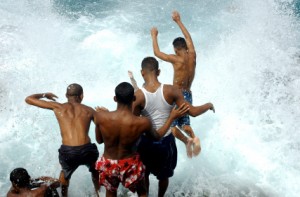The Last of Thumb Thinking

Sure it’s dangerous. But we’re in control. No problem!
Heuristics are simply rules of thumb. They help us make decisions quickly and, in most cases, accurately. They help guide us through the day. Most often, we’re not even aware that we’re making decisions. Unfortunately, some of those decisions can go haywire — precisely because we’re operating on automatic pilot. In fact, psychologists suggest that we commonly make 17 errors via heuristics. I’ve surveyed 11 of them in previous posts (click here, here, and here). Let’s look at the last six today.
Optimistic bias — can get us into a lot of trouble. It leads us to conclude that we have much more control over dangerous situations than we actually do. We underestimate our risks. This can help us when we’re starting a new company; if we knew the real odds, we might never try. It can hurt us, however, when we’re trying to estimate the danger of cliff diving.
Hindsight bias — can also get us into trouble. Everything we did that was successful is by dint of our own hard work, talent, and skill. Everything we did that was unsuccessful was because of bad luck or someone else’s failures. Overconfidence, anyone?
Elimination by aspect — you’re considering multiple options and drop one of them because of a single issue. Often called, the “one-strike-and-you’re-out” heuristic. I think of it as the opposite of satsificing. With satsificing, you jump on the first solution that comes along. With elimination by aspect, you drop an option at the first sign of a problem. Either way, you’re making decisions too quickly.
Anchoring with adjustment — I call this the “first-impressions-never-die” heuristic and I worry about it when I’m grading papers. Let’s say I give Harry a C on his first paper. That becomes an anchor point. When his second paper arrives, I run the risk of simply adjusting upward or downward from the anchor point. If the second paper is outstanding, I might just conclude that it’s a fluke. But it’s equally logical to assume that the first paper was a fluke while the second paper is more typical of Harry’s work. Time to weigh anchor.
Stereotyping — we all know this one: to judge an entire group based on a single instance. I got in an accident and a student from the University of Denver went out of her way to help me out. Therefore, all University of Denver students must be altruistic and helpful. Or the flip side: I had a bad experience with Delta Airlines, therefore, I’ll never fly Delta again. It seems to me that we make more negative stereotyping mistakes than positive ones.
All or Nothing — the risk of something happening is fairly low. In fact, it’s so low that we don’t have to account for it in our planning. It’s probably not going to happen. We don’t need to prepare for that eventuality. When I cross the street, there’s a very low probability that I’ll get hit by a car. So why bother to look both ways?
As with my other posts on heuristics and systematics biases, I relied heavily on Peter Facione’s book, Think Critically, to prepare this post. You can find it here.